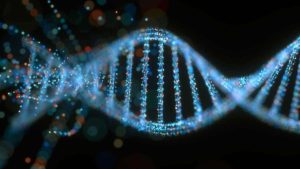
The Surprising Connections Between Disease and Longevity

The Surprising Connections Between Disease and Longevity
 Historically, a person’s DNA has been thought of as a rigid template for growth, with a single gene coding for a specific trait. In this model, the only way that evolution could occur is through natural selection acting on random mutations to the genome. It has since been proved that the process is a bit more complicated than this. It seems as if only 3% of a person’s DNA actually codes for specific proteins and the remaining 97% is noncoding DNA, meaning we are not quite positive of its purpose. In addition, the one gene per trait theory has been replaced by the thought that genes are integrative and multiple genes can contribute to a singular trait and vice versa. It has also been determined that random mutation would not be able to explain certain traits that have evolved because the chance that the correct mutation occurred in the exact correct location is almost unfathomable. Instead, much research has been conducted that has discovered the existence of “jumping genes.” Jumping genes, also called transposons, are activated during times of internal or external stress, either copying and pasting or cutting and pasting themselves into specific segments of coding DNA. It is currently understood that by doing this, jumping genes are increasing the rate of mutation in an organized fashion and increasing the likelihood that they will, in a way, “speed up” the evolutionary process in order to better survive in their current situation. About 50% of noncoding DNA is now considered to consist of numerous jumping genes. Even more recently, researchers have come across new evidence that points to viruses as being the main cause of this noncoding portion of our DNA. In the chapter, Dr. Moalem indicates that jumping genes, and therefore noncoding DNA, have a composition that looks very similar to that of viruses. Since the beginning of history, viruses have been infecting host cells and taking over the cells genetic machinery in order to replicate. Some viruses, known as retroviruses, are even able to write themselves into their host’s DNA, literally changing a person’s genetic makeup. The current theory is that over time, some virus DNA that has been inserted into the human genome has been beneficial, such as jumping genes, and has increased the rate and ability of human evolution.
Historically, a person’s DNA has been thought of as a rigid template for growth, with a single gene coding for a specific trait. In this model, the only way that evolution could occur is through natural selection acting on random mutations to the genome. It has since been proved that the process is a bit more complicated than this. It seems as if only 3% of a person’s DNA actually codes for specific proteins and the remaining 97% is noncoding DNA, meaning we are not quite positive of its purpose. In addition, the one gene per trait theory has been replaced by the thought that genes are integrative and multiple genes can contribute to a singular trait and vice versa. It has also been determined that random mutation would not be able to explain certain traits that have evolved because the chance that the correct mutation occurred in the exact correct location is almost unfathomable. Instead, much research has been conducted that has discovered the existence of “jumping genes.” Jumping genes, also called transposons, are activated during times of internal or external stress, either copying and pasting or cutting and pasting themselves into specific segments of coding DNA. It is currently understood that by doing this, jumping genes are increasing the rate of mutation in an organized fashion and increasing the likelihood that they will, in a way, “speed up” the evolutionary process in order to better survive in their current situation. About 50% of noncoding DNA is now considered to consist of numerous jumping genes. Even more recently, researchers have come across new evidence that points to viruses as being the main cause of this noncoding portion of our DNA. In the chapter, Dr. Moalem indicates that jumping genes, and therefore noncoding DNA, have a composition that looks very similar to that of viruses. Since the beginning of history, viruses have been infecting host cells and taking over the cells genetic machinery in order to replicate. Some viruses, known as retroviruses, are even able to write themselves into their host’s DNA, literally changing a person’s genetic makeup. The current theory is that over time, some virus DNA that has been inserted into the human genome has been beneficial, such as jumping genes, and has increased the rate and ability of human evolution.